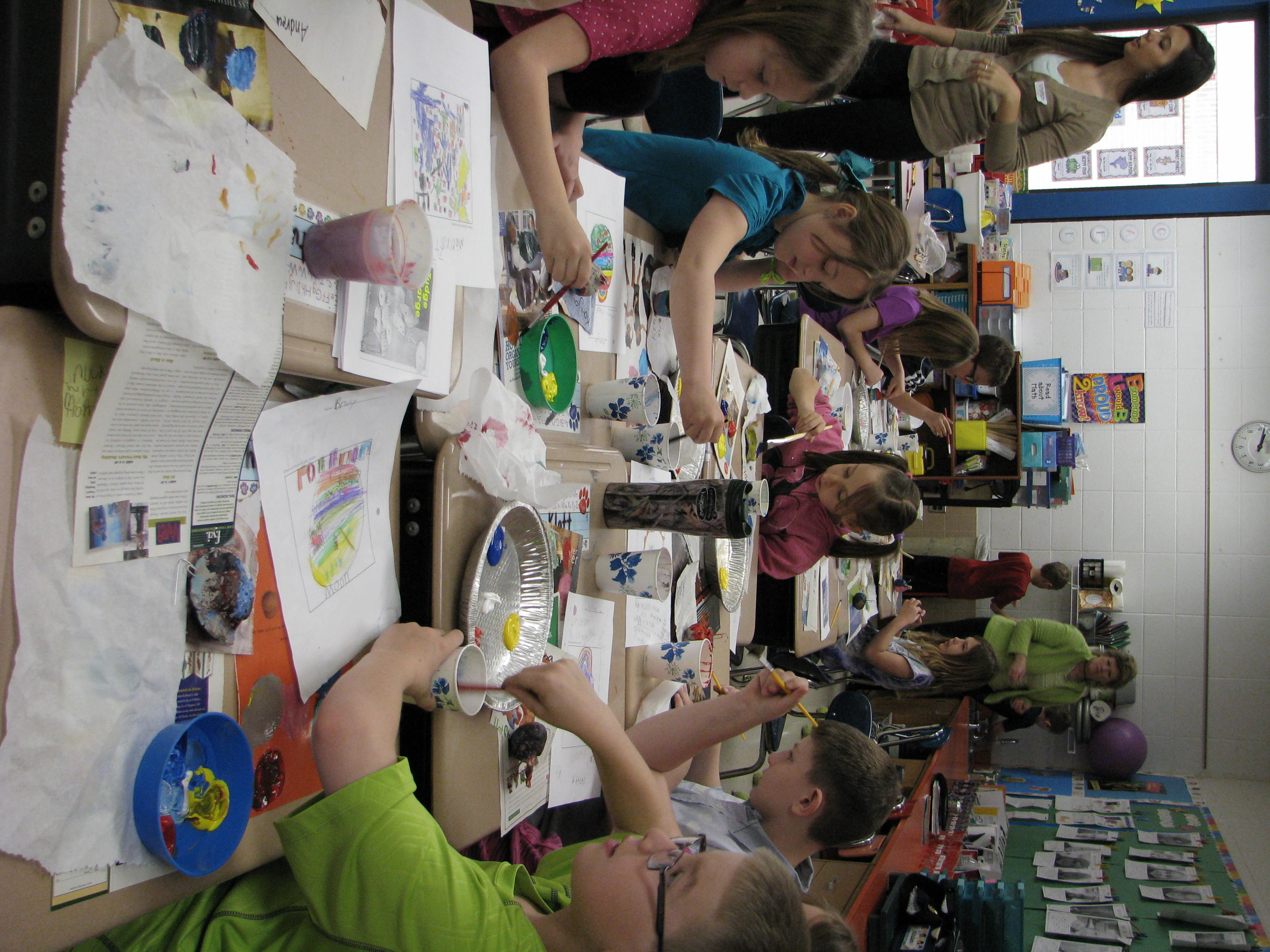Name of Project: Earth's Moonscape
Grade Level or Age of Participant: 2nd Grade
School, Teacher and Classroom: Monica Derby
MCAD Teaching Artist: Kacey Medenwaldt
Visual Arts Content or Standards
Create or make a variety of contexts in the arts area using the artistic foundations.
Demonstrate understanding of the personal, social, cultural and historical contexts that influence the arts areas.
Demonstrate knowledge of the foundations of the arts area.
Curricular Link / Standards
Presentation of knowledge and ideas: 2.8.5.5 Create audio recordings of stories or poems; add drawings or other visual displays to stories or recounts of experiences when appropriate to clarify ideas, thoughts, and feelings.
Research to build and present knowledge: 2.6.8.8 Recall information from experiences or gather information from provided sources to answer a question.
Overview of Project
After reading "The Moon" by Seymour Simon students will use their knowledge to create a new, imagined moon for earth. We will begin by discussing the Earth's moon and how some planets have multiple moons we will consider the possibilities and features of those moons. Through writing and drawing, they will re-imagine a new moon for Earth. Beginning with a worksheet, they will illustrate their moon and write a paragraph describing the landscape, climate, size, shape, in habitability, and additional details. After brainstorming and imagining group and individual brainstorming in writing and 2 dimensions, they will create a 3D model from clay, sculpting and painting the landscape.
“Big Ideas”/ Essential QUESTION(s)
How do moons associate themselves with their planet?
What makes a moon?
Student Outcome Objectives, students will:
Understand there are endless opportunities to different outcomes
The ideation process is critical to problem solving and creativity.
Use their imagination to invent and problem solve.
Create a 'new' moon concept for Earth's moon.
Prior Knowledge
The class must have read The Moon by Seymour Simon
Lesson Preparation Timeline
Meet with collaborating instructor to align project with curricular content and consider visual arts options
Write Planning Backward Lesson Plan and submit to to collaborating teacher for critical response. Review edits and revise as necessary.
Submit final lesson plan to collaborating teacher.
Prepare materials - purchase clay, paints
Teach class - three days / 1 hour sessions
Final reflections with class and collaborating instructor
Examples of Artwork
http://www.nasa.gov/multimedia/imagegallery/index.html
Pre-made examplars
Assessment
Student work should demonstrate individual and unique landscapes. Students will support their decisions.
Materials
Day 1 / Brainstorming
Worksheet - to write about and visualize the imagined moon
Quality colored pencils
Graphite pencils
Erasers
Day 2 / Sculpting the Moon
White air dry clay - 25 lbs cut into 24 equal rectangles
Clay tools for pattern and texture such as toothpicks, pastic forks, stamps, netting, etc.
Hooks for hanging
Water containers that will not tip to be washed and saved
Waste paper to cover tables
Masking tape to tape down waste paper
Hand wipes for dirty finger
Aprons or art shirts
Day 2 / Painting the Moon
Acrylic paint in primary colors: Primary Red, Primary Blue, Primary Yellow and Titanium White. (No Black)
Color Wheel
Brushes - small rounds and large flats
Plastic plates for paint palettes to be washed and saved
Waste paper to cover tables
Masking tape to tape down waste paper
Hand wipes for dirty finger
Aprons or art shirts
Learning Activities and Timing
Day 1 (60 minutes) Brainstorming
Prep and set up (15 minutes)
Slideshow - "What Makes a Moon?" (10 minutes)
Hand out and explain worksheet (5 minutes)
Work Time (35 minutes)
Present work and or ideas (15 minutes)
Clean up (5 minutes)
Day 2 (60 minutes) Sculpting
Prep time and materials preparation and set up at tables. (30 minutes)
Lesson overview and introduction to working with clay, objectives, rules, possibilities (10 minutes)
Clay demonstration: how to create a form, creating pattern and texture, insert hooks for hanging (15 minutes)
Hand out clay. (5 minutes)
Work on sculptures. (30 minutes)
Clean up (5 minutes)
Day 3 (65 minutes) Painting
Prep time and materials preparation and set up at tables. (30 minutes)
Lesson overview and objectives (5 minutes)
Painting demonstration and introduction to mixing colors, painting strategies and techniques (15 minutes)
Hand out paint palettes and sculptures. (5 minutes)
Work time. (30 minutes)
Clean up (5 minutes)
Class Reflection: What did you learn about moons, clay and painting? (10 minutes)
Document and install work in classroom or in hallway presentation cases with description of the process. (45 minutes)
Teacher Artist Reflection
The problems are anticipated are that some students may have a hard time thinking of what they want their moon to look like.
Some students will want to have a big moon, than essentially use a lot of clay.
This project would be a good introduction into science and astronomy.
Reflection on content and process with both collaborating instructor and the students.






